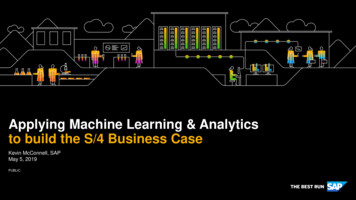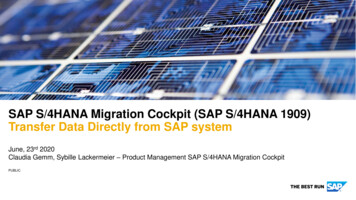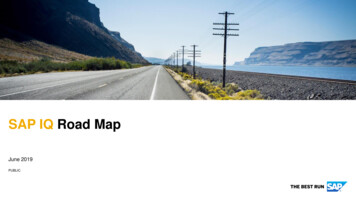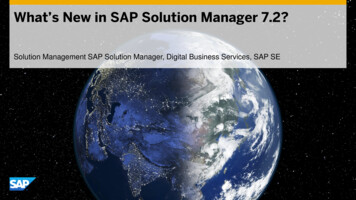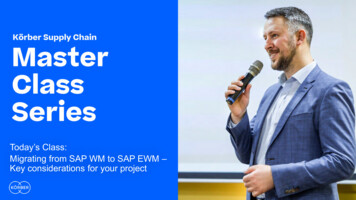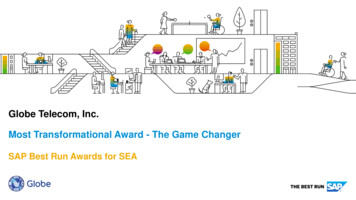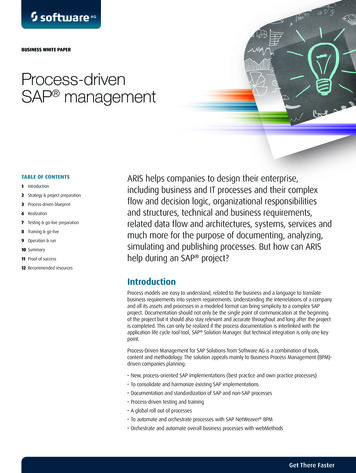
Transcription
BUSINESS WHITE PAPERProcess-drivenSAP managementTABLE OF CONTENTS1Introduction2 Strategy & project preparation3 Process-driven blueprint6 Realization7 Testing & go-live preparation8 Training & go-live9 Operation & run10 Summary11 Proof of successARIS helps companies to design their enterprise,including business and IT processes and their complexflow and decision logic, organizational responsibilitiesand structures, technical and business requirements,related data flow and architectures, systems, services andmuch more for the purpose of documenting, analyzing,simulating and publishing processes. But how can ARIShelp during an SAP project?12 Recommended resourcesIntroductionProcess models are easy to understand, related to the business and a language to translatebusiness requirements into system requirements. Understanding the interrelations of a companyand all its assets and processes in a modeled format can bring simplicity to a complex SAPproject. Documentation should not only be the single point of communication at the beginningof the project but it should also stay relevant and accurate throughout and long after the projectis completed. This can only be realized if the process documentation is interlinked with theapplication life cycle tool tool, SAP Solution Manager. But technical integration is only one keypoint.Process-Driven Management for SAP Solutions from Software AG is a combination of tools,content and methodology. The solution appeals mainly to Business Process Management (BPM)driven companies planning: New, process-oriented SAP implementations (best practice and own practice processes) To consolidate and harmonize existing SAP implementations Documentation and standardization of SAP and non-SAP processes Process-driven testing and training A global roll out of processes To automate and orchestrate processes with SAP NetWeaver BPM Orchestrate and automate overall business processes with webMethodsGet There Faster
Business White Paper Process-Driven SAP ManagementREAD THIS WHITE PAPER TO FIND OUT: How can my organization benefit from using ARISin SAP projects? What tool-related functionalities are offeredwithin ARIS for SAP Solutions? What are Process-Driven Management for SAPSolutions all about?With process-driven SAP management, you can leverage IT assets and reduce total cost ofownership as well through reducing upgrade and implementation project times drastically andsimplifying customizing based on business process requirements.The Software AG solution supports all the main SAP project types you encounter: SAP redocumentation SAP implementation SAP upgrade SAP harmonization and optimization SAP template and roll outFigure 1: The Software AG solution supports all SAP project types and the complete SAP project life cycle.Strategy & project preparationIn order to make the best decision about an SAP solution, companies have to do their“homework.” This includes the documentation of their enterprise strategy and business model,understanding core competencies as well as value opportunities. This is key to understanding anddefining the right business requirements and to match this with the solution offerings fromSAP AG.Strategy documentationComing from the business strategy and business process analysis perspectives, ARIS supports thedefinition and modeling of strategic aspects of your business, e.g., with the balanced scorecardand Key Performance Indicators (KPIs) to be considered, and interlinks them with your processlandscape.2Get There Faster
Business White Paper Process-Driven SAP ManagementSAP content importIn a second step, it is possible to import the SAP Business Process Repository (BPR) content viathe synchronization feature and get an overview of SAP best practice and standard processes.Content that is being imported includes SAP industry scenarios (e.g., automotive, banking ), SAPbest practices, product scenarios (e.g., SAP CRM, ERP) and their respective business processes,process steps and general documentation as well as SAP standard configuration content includingtransactions, organizational units, roles, master data and test cases.Figure 2: Redocumentation as a starting point for a process-driven SAP projecSAP redocumentationIf SAP is already in place, but documentation is outdated, it could be valuable to create aninventory of SAP systems running and understand what SAP functionalities are currently usedand how they are used.Software AG’s redocumentation service for SAP systems provides documentation on enterprisestructure, organizational units, document types, standard and customized transactions andreports as well as usage calculation of transactions, documents and reports in a Microsoft Excel sheet format or populated ARIS models.The result of the redocumentation will support the next stages of the SAP project and canbe re-used while doing the to-be process definition or consolidation of existing SAP clients(organizational structures). Due to the identification of redundant or unnecessary functionalitiesand re-use of the redocumentation results in the upcoming blueprint phase, this can significantlyimprove and speed up the solution to be implemented.Process-driven blueprintUsing either the Industry.PerformanceREADY, SAP BPR content and redocumentation resultsthe scoping and blueprinting are conducted in ARIS. Here, the blueprint relevant information isdocumented within process models describing the business requirements end-to-end.ARIS models the documentation of the interrelations of business processes, the executingorganization/role, the relevant system down to transaction level, input and output data andrelated documents as well as interface requirements and other RICEF relevant artifacts. It,therefore, combines business requirements with the SAP blueprint in one view both business andIT can understand.Get There Faster3
Business White Paper Process-Driven SAP ManagementFigure 3: Example of a process-driven blueprint definition with an Event-driven Process Chain (EPC) modelThese process models define the contract between the end-user requirement and the softwarefunctionality to ensure that expectations and realization match. Many customers are using theprocess documentation for process analysis and harmonization of multiple process areas orexisting ERP solutions. Another important use case for this process definition exercise is thedesign of a global process template to be rolled out across local implementations.SAP process designGoing through this documentation exercise, the user is supported by tool wizards to ensureconsistent modeling and the re-use of existing objects within the ARIS database, including: SAP method wizard – user can select model, object, symbol and connection types to be usedin ARIS for synchronization that complies with the project standards Wizard to create SAP-functions – guided by questions all required attributes are storedautomatically to ensure synchronization conformance Wizard to create SAP transactions in ARIS – ensures correctness and re-use of existingobjects Wizard to create SAP documentation in ARIS – asks all required information to uploaddocument into SAP Solution ManagerSynchronization between ARIS for SAP Solutions & SAP SolutionManagerAfter documentation and analysis of the relevant processes in ARIS as well as internal approval,the processes can be transferred to SAP Solution Manager. The interface exchanges only theconfiguration-relevant information that will be stored in SAP Solution Manager and also translatesthe EPC models into the hierarchical structure offered in SAP Solution Manager to store theinformation.4Get There Faster
Business White Paper Process-Driven SAP ManagementFigure 4: Data synchronization between ARIS and SAP Solution ManagerNow the IT project team adds to this documentation in the blueprint and configuration phase,which can be synchronized with ARIS in order to seamlessly integrate the business and IT view.ARIS for SAP Solutions supports the synchronization of the following information: Synchronization of template, implementation & maintenance projects Synchronization of process architecture Three-layer structure covering scenarios, processes, process steps Flexible process sequence SAP and manual steps Short cut concept enabling the synchronization of occurrence copies and translation intoshort cuts in SAP Solution Manager Synchronization of all SAP transaction types Synchronization of SAP Solution Manager system landscape (logical and physical components) Synchronization of end-user roles Synchronization of keywords Synchronization of attached documents & documentation links (with SAP knowledgewarehouse) for general (template projects), project, test & training documentation Synchronization of customer attributes defined in SAP Solution Manager and mapped with ARISattributes Transfer of master data, organizational structureSynchronization via Web serviceFurthermore, is it advisable to define and automate the governance process for modeling,release cycle management, approval, synchronization and publishing of processes if many usersare involved. The service-enabled synchronization functionality can make the synchronizationprocess seamless and ensures documentation quality and consistency throughout and afterthe project. This also simplifies more complex project scenarios, including change requestmanagement, project maintenance and global template roll outs.Get There Faster5
Business White Paper Process-Driven SAP ManagementProcess analysis & reportingEven in early project phases, it is advisable to use the ARIS Publisher component to communicatethe status of the project or in order to get early feedback from the users and project teammembers.Once the modeling is completed, the ARIS models can be re-used for various documentation andanalysis requirements: Automatic creation of blueprint document Create and update RICEF specifications Technical design document RACI charts Authorization/security conceptsFigure 5: Re-use process models to create required project documentation automaticallyLeveraging the modeled information in ARIS cannot only improve the project communication andchange management process but saves valuable time and resources throughout the rest of theproject.RealizationDuring the technical implementation and realization phase, the integration between ARIS andSAP Solution Manager is advantageous for both business and IT. From the process models in ARIS,the user can directly jump into the business blueprint transaction (SOLAR 01) or configurationtransaction (SOLAR 02) of the selected blueprint item, access the relevant documents from theSAP Knowledge Warehouse and start the SAP transaction directly. The link to the published ARISmodels can be transferred back into SAP Solution Manager, so the configuration team can directlyview the published ARIS model without requiring ARIS access or knowledge.6Get There Faster
Business White Paper Process-Driven SAP ManagementFigure 6: ARIS model embedded in SAP Solution ManagerMost of the configuration relevant information is now in SAP Solution Manager. However, ifprocess changes are required, they must be done in ARIS. Changes on the transactional level andon technical documentation can be done in SAP Solution Manager and transferred back into ARISto make sure that modeled business processes comply with implemented SAP reality.Testing & go-live preparationA critical phase in an SAP project is testing and go-live preparation. Time and resources areinsufficient; end users require support and need to adopt the new processes and IT systemsquickly. Again, the re-use of process models for testing, training and end-user communication issupported by the combination of tools and their functionalities.Process-based testingA major resource eater (up to 9 percent) and error-prone step during this late project phase isthe definition of integration test scenarios. High-quality testing can only be ensured by goodknowledge and documentation of all process variations, the close collaboration between the enduser and the IT project team as well as testing tools to partly automate this step and documentthe results properly.The re-use of existing process models can help in combination with ARIS Test Designer whichis used to define integration tests based on the process models documented in ARIS. Goingacross the models, end-to-end processes are recorded and documented using an easy-to-useand intuitive graphical interface. This ensures, first of all, that the system actually correspondsto the designed business processes and the processes tested correspond to the processesimplemented, which in turn helps to ensure quality in testing and implementation. Besidesthe recording of the various end-to-end scenarios, the related test-case documentation canbe created including a graphical representation of the selected model path and all relevantfunctions, expected results (events/outcome), required roles, transactions, data input and outputand additional pre-defined test-related attributes maintained in ARIS.Depending on the selected testing tool, these test cases can be transferred into SAP SolutionManager for test plan creation in the SAP test workbench or directly transferred into HP QualityCenter or other testing environments to execute the testing.Get There Faster7
Business White Paper Process-Driven SAP ManagementFigure 7: ARIS Test Designer with different interface scenariosUsing ARIS Test Designer thereby saves time re-using previously modeled processes, minimizesproject risks and improves process and system quality. In addition, including the end user in thevalidation of process models and definition of test scenarios ensures high user acceptance andmotivation. This in turn increases project success and delivery in time and quality.Training & go-liveDefining the right training requirements globally for the new solution is another challenge forthe project team. Fortunately all required information is already documented in ARIS. Evaluatingthe relation between the business roles, the processes they perform and the related transactionsrequired automatically documents the training requirements without filling out endless MicrosoftExcel sheets. Using standard reports in ARIS, this information can be filtered and even publishedfor all end users to refer to.User acceptance and understanding is an important factor for project success. The documentationcreated in previous project phases and stored in ARIS for SAP Solutions, SAP SolutionManager and other documentation solutions can be transferred back into ARIS as the centralcommunication platform for project team and end users.For global template roll-out projects this central communication platform improves greatly theclose collaboration between remote project teams working on local implementations of thesetemplate processes.Process publicationUsing the publishing component ARIS Publisher, this documentation can be made availableglobally to everyone via intranet even in early project phases for review, communication andtraining purposes. The process models can be explored, and all documentation stored in varioustools and places (e.g., SAP knowledge warehouse and RWD) can be accessed directly from themodels using easy search capabilities and role-based access. Project news, highlighting processchanges and feedback via email can help ensure the models.8Get There Faster
Business White Paper Process-Driven SAP Managementsupport the whole change-management process within the company.Figure 8: Open SAP transaction and documentation from published process models and vice versaNot only the processes and documentation are interlinked. The ARIS online guide functionalityenables the user to “jump” to the relevant SAP transaction directly from the model. This is aperfect way to re-use the process models during end-user training. This functionality is alsoavailable vice versa: Within the SAP transaction the process model describing the relevantbusiness process can be accessed and all attached documentation as well. The user is able tounderstand the business process he is currently executing, can read valuable documentation ondata entry and access related training material.Operation & runTo profit from the holistic documentation after go-live, it is important to ensure the integrationbetween the running solution and the documentation in ARIS. Changes can happen on thetechnical side coming from change requests in SAP Solution Manager or business-relatedchanges can have impact on the supporting SAP systems.Change request managementEnsuring continuous accuracy of documentation is crucial for future changes, upgrades andimplementation projects. ARIS for SAP Solutions has the ability to synchronize with the runningSAP solution via the use of maintenance projects. Hereby, the relations between the processmodels in ARIS and the processes of the maintenance project that were originally documentedin an implementation project are reactivated. This gives the project team a valuable overviewon the processes affected by the change, the need for process adjustments to be made, relateddocumentation changes and training needs. The to-be process models should be designed,reviewed and updated in ARIS before implementing them in SAP. Technical changes however canbe documented in SAP Solution Manager and transferred back into ARIS and published to theuser community.Depending on the amount of changes and the size of the project team and process ownersinvolved, it makes sense to integrate the SAP Solution Manager change request managementworkflow with the ARIS Process Governance workflow. This is possible via Web services andadjustable to the project needs. So the right people can be notified, tasks can be allocated by theengine as well as automatic synchronization and publishing can be triggered.This change request process can also be triggered by the viewer of the published processes—either by giving feedback on the model content or by starting a change request directly fromhere, thus optimizing the communication between end user, project team and IT department.Get There Faster9
Business White Paper Process-Driven SAP ManagementOutlookWith its latest release, ARIS offers many great new features to simplify the modeling andevaluation process significantly. ARIS for SAP Solutions will be extending the synchronizationscope including interface scenarios, authorization roles, global attributes and Business ProcessModeling Notation (BPMN ) 2.0 models as well as improving existing features like Test Designer,ARIS Online Guide, administration and many more.Besides the synchronization with SAP Solution Manager, ARIS for SAP Solutions will offer thetransformation of EPC models into BPMN 2.0 and the possibility to export models via a standardBPMN 2.0 export functionality. With this ability BPMN 2.0 models can be imported into SAPNetWeaver BPM for process orchestration and execution.Figure 9: Models can also be transferred via BPMN 2.0 interface into SAP NetWeaver BPMSummaryProfiting from the long-time partnership with SAP AG and 20 years of SAP consultingexperience, our products and solutions enable companies to reduce their total cost of ownershipand increase return on investment through continuous improvement and integration betweenSAP and business processes while implementing SAP solutions.Benefits of Software AG’s solution at a glanceBenefits of using Process-Driven Management for SAP Solutions range from saving time andmoney through multiple re-use of content, less change requests during project life cycle offaster identification of gaps and opportunities. Automated project document generation as wellas faster conception and creation of tests and trainings underline the power of the solution.Delivering projects on time and budget is only one side of the coin. Quality is another. Businessprocess-related requirement definition leads to higher accuracy of the designed solution, stablealignment of business and IT as well as a complete and integrated project information platform,which are key to the high quality of the end solution.Positive “side effects” we encounter higher management commitment, better end-useracceptance and increased process competence.10Get There Faster
Business White Paper Process-Driven SAP ManagementProof of successFigure 10: A successful solution proven in many process-oriented SAP projectsFaster global roll out implementation time at AB VolvoAB Volvo has created a roll-out kit for standardizing SAP processes worldwide. Using our solution,Volvo shortened implementation lead time, saving approximately 30 percent per roll out whilereducing support and maintenance costs.Helen Kylstad states: “The process-driven SAP management approach increases the businessunderstanding and structures all documentations from solution descriptions, test scripts, trainingmaterial down to configuration rules and guidelines. This together with roll out roadmaps securethat we have one common view and place where business solution owner, line operation staff,maintenance of product organization meet and collaborate in an efficient way. The roll-out trackindicates savings of approximately 30 percent.”Reduced process documentation times and lower costs at Evonik IndustriesThe roll out of the SAP platform in Greater China was supported by good-practice processes fromEurope and the USA, which were adapted to local requirements. Benefits included substantiallyreduced process documentation times, resulting in lower costs.Thomas Goebel from corporate IT explains: “Having ARIS as a support tool meant we were ableto slash project documentation times, plus it gave us a highly efficient way of communicatingwithin the project team At the same time, it helped us organize our workshops efficiently andtrain users because we’d all been talking about exactly the same processes.”Get There Faster11
Business White Paper Process-Driven SAP ManagementAbout the authorAfter studying business administrationwith honors, Josèphe Blondaut hasbeen working in the areas of BPM,SAP consulting and marketing formany years. She started in SAPimplementation projects, took overresponsibilities as CRM marketingsenior consultant and successfullysupported international customerswithin various industries on numerousERP implementation and optimizationprojects. In her role at Software AG as aproduct marketing manager for ARIS forSAP Solutions, she is responsible for allSAP-related ARIS products. She worksclosely with the product managementand supports the cooperation betweenSoftware AG and SAP globally.Better process control at BrenntagWorld leader in international chemistry distribution, Brenntag now has a Europe-wide processframework using our solution. SAP implementation projects are 25 percent faster. SAP projectcosts are down 10 percent.Ludger Kruse, project manager, corporate IT, confirms: “Business Process Management atBrenntag is a Europe-wide framework and enables permanent, fast and multiple re-usabledesign, management and control of processes. BPM at Brenntag is continuous processimprovement by use of a common modeling standard.”Recommended resourcesVisit www.softwareag.com/resources for the latest white papers, tutorials, webinars, articles andcustomer successes on process-driven SAP management. Learn more about our solution at www.softwareag.com/sap. Discover the value of consulting services at www.softwareag.com/services.Find out how to power up your Digital Enterprise at www.SoftwareAG.comABOUT SOFTWARE AGSoftware AG helps organizations achieve their business objectives faster. The company’s big data, integration and businessprocess technologies enable customers to drive operational efficiency, modernize their systems and optimize processes for smarterdecisions and better service. Building on over 40 years of customer-centric innovation, the company is ranked as a “leader” in 14market categories, fueled by core product families Adabas-Natural, Alfabet, Apama, ARIS, Terracotta and webMethods.Learn more at www.SoftwareAG.com. 2014 Software AG. All rights reserved. Software AG and all Software AG products are either trademarks or registered trademarks ofSoftware AG. Other product and company names mentioned herein may be the trademarks of their respective owners.SAG Process-Driven SAP Management 12PG WP Mar14Get There Faster
Process-Driven Management for SAP Solutions from Software AG is a combination of tools, content and methodology. The solution appeals mainly to Business Process Management (BPM)- . Figure 3: Example of a process-driven blueprint definition with an Event-driven Process Chain (EPC) model



